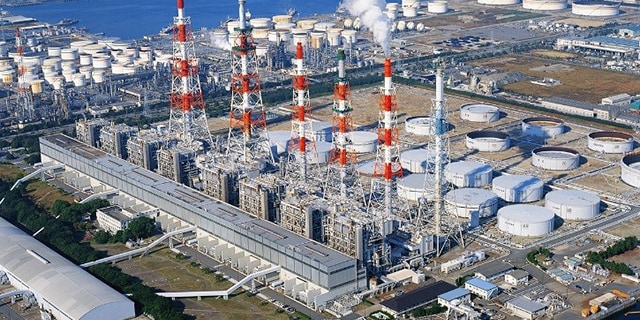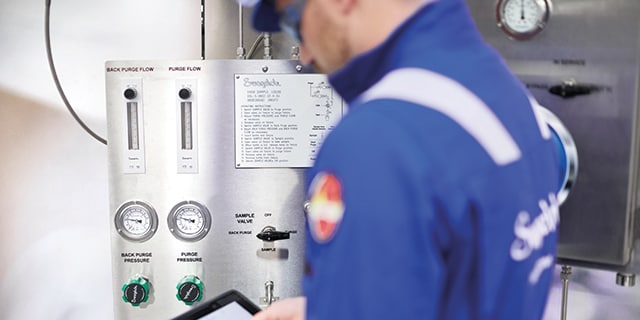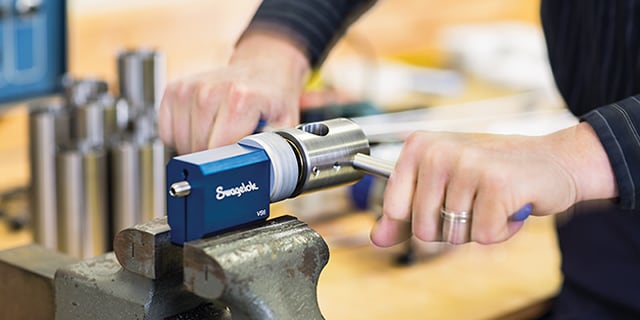Solving Semiconductor Fabrication Challenges with Insulated Hoses

Solving Semiconductor Fabrication Challenges with Insulated Hoses
Doug Nordstrom, Senior Product Manager, Hose Products and Yoon Jiang , Regional Market Manager, Semiconductor
In the world of semiconductor chip production, precision and cleanliness are intersecting priorities. Temperatures inside the chamber must be kept at optimized levels to ensure process stability. This can be challenging due to the extreme heat necessary to maintain appropriate flow of process gases. Simultaneously, the chamber must be kept entirely free of potential contaminants to maximize the throughput of chips during the delicate fabrication process.
Because significant engineering and design go into creating and maintaining an ideal fabrication environment, it can be easy to overlook the importance of selecting some of the more “basic” components supporting the chip production process. Consider a simple industrial hose, which is used in countless applications throughout the world of manufacturing. In the semiconductor fabrication process, hoses play an important role, as they are commonly used to help powerful chillers regulate the environment necessary for production processes.
Like anything else in the semiconductor process, there are a few special considerations that should be made when choosing the right hoses to maintain an optimal production environment. Selecting the appropriate degree of insulation for hoses, for instance, is crucial to not only regulate temperatures during chip manufacturing, but to avoid unnecessary risks and costs in your operations.
Here are some factors to consider as you evaluate insulated hose solutions to optimize your costs and results:
Maintaining optimal fluid temperature control. Temperature stability in the deposition chamber is critical for efficient semiconductor production. Those temperatures are often regulated by powerful chillers that utilize coolants pumped in and out by one or more hoses—and if not properly insulated, coolant hoses can be one area where that stability can be compromised.
Fluid temperatures will naturally rise during transportation from the chiller to the processing environment. If a hose is not outfitted with the proper insulation, temperatures in the chamber may not be at optimal levels if the chiller is not compensating for that rise in temperature in the coolant lines.
While general industrial applications might simply utilize water as a coolant, semiconductor applications often use a coolant like glycol that may reach temperatures as low as -40 C. This is an energy-intensive process, and by maintaining the temperature of the coolant more effectively than a standard industrial hose, an insulated solution can facilitate far better temperature control for lines carrying fluids at these super-cold temperatures. It is in a semiconductor manufacturer’s best interest to maintain the proper temperatures as efficiently as possible, both to maintain high-quality outputs from the chip fabrication process and to minimize energy costs.
Combating condensation. Inadequately insulated hoses can act like a glass of ice water on a hot day; if the hose’s surface temperature is below the ambient dew point, condensation will form on the hose’s exterior. Condensation can also occur if two cold hoses are routed too closely together, causing each other’s surfaces to become colder than if they were isolated.
Like in many industrial applications, condensation can be an issue for a semiconductor manufacturer. When hoses are routed through confined areas, like a subfloor, undetected dripping from condensation could jeopardize adjacent sensitive equipment, such as electronics, causing damage and potentially resulting in process downtime. In non-confined, highly trafficked areas, pipes or hoses with condensation droplets could also create a slip hazard.
Additionally, small puddles of liquid found near any industrial application can necessitate an investigation into the cause, which can lead to unnecessary downtime and resource allocation. Choosing hoses with the right insulative properties can help prevent condensation and associated issues like these.
What to look for in insulated hoses. When selecting an insulated hose for chiller applications, it is important to choose a material that was designed specifically for cold temperatures. While some insulated options may be marketed for use in both hot and cold fluid transfer applications, the fact is that different types of insulation perform differently depending on the process in which they are used. For example, a hose featuring a flexible polyolefin heat shrink cover has been demonstrated to perform better in cold applications than insulated hoses with fabric coverings, which are more suited for high-temperature fluid applications. Seek out hose suppliers that understand which types of materials work best for the application, and why, then choose only insulated hoses that are optimized to perform in your end use environment.
It is also important that, no matter the insulative material used, the hose remains flexible enough for optimized routing and installation. A hose’s minimum bend radius, for example, should not change with insulation, nor should that bending capability compromise its insulative properties. Look for options that properly maintain the target temperature of the fluid you are transporting, do so flexibly, and are also not too bulky, such as a hose featuring low thermal-conductivity aerogel insulation material.
Finally, an insulated hose that brings true efficiency to an application is one that uses only as much insulation as is required. Rather than a one-size-fits-all approach, a good hose supplier can offer different layering options that can cost-efficiently meet the temperature requirements of your application. In the best-case scenario, they will request the parameters of your application and use an equation to determine exactly how much insulation will be right for your specific hose needs.
A smart, cost-effective solution. Semiconductor fabricators who want to drive down costs should consider looking beyond the expensive manufacturing tools at the center of their processes to find less obvious, but highly cost-effective opportunities for improvement throughout their facilities. Evaluating their suite of hoses for cold-temperature fluid transfer applications and selecting appropriate hose insulation options could prove to be a worthy exercise.
If you are unsure of where to begin, Swagelok can help. Our goal is to work collaboratively with our customers to meet these needs, whether that means offering a variety of insulated hose options that can be tailored to your requirements or coming on-site to advise on the best opportunities to bring true efficiency to your operation. Reach out to your local authorized sales and service center to talk through your needs, and together, we will find a solution that is right for you.
Related Articles

Refinery Safety Depends on Well-Trained, Empowered Employees
Fugitive emissions of hazardous gases can occur in refineries. Safe, leak-free containment depends on knowledgeable and empowered teams.

Five Considerations for Your Analyzer Shelter
Analyzer shelters are an important part of any industrial refinery or other oil and gas facility. Learn some fluid and sampling system concerns to think about from Swagelok.

Find the Right Tool for the Job: Considerations for Plant Equipment
Which tools and equipment must plant operators and technicians keep on hand at all times? From advanced orbital welding systems to basic tube deburring tools, there are essential tools for every connection, and it pays to be prepared.

